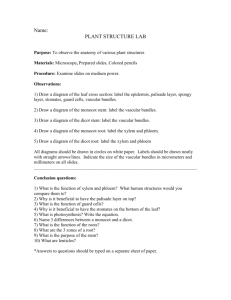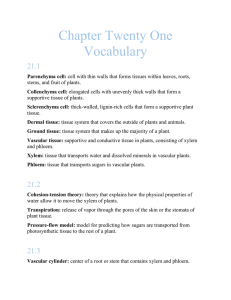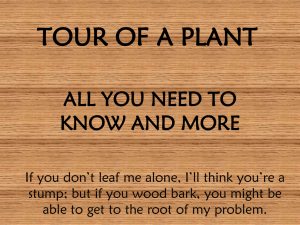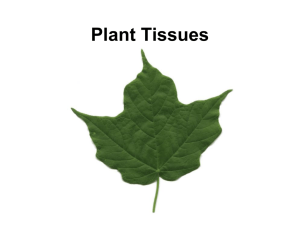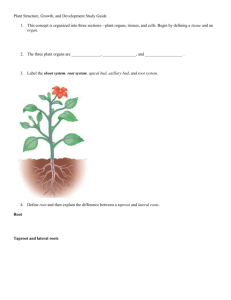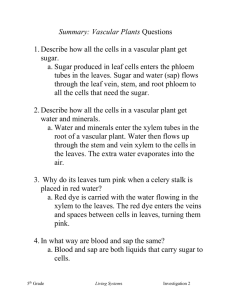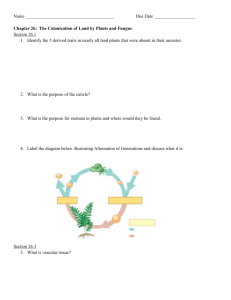Biology CP Plant Ch. 20,21,22 ppt notes
advertisement
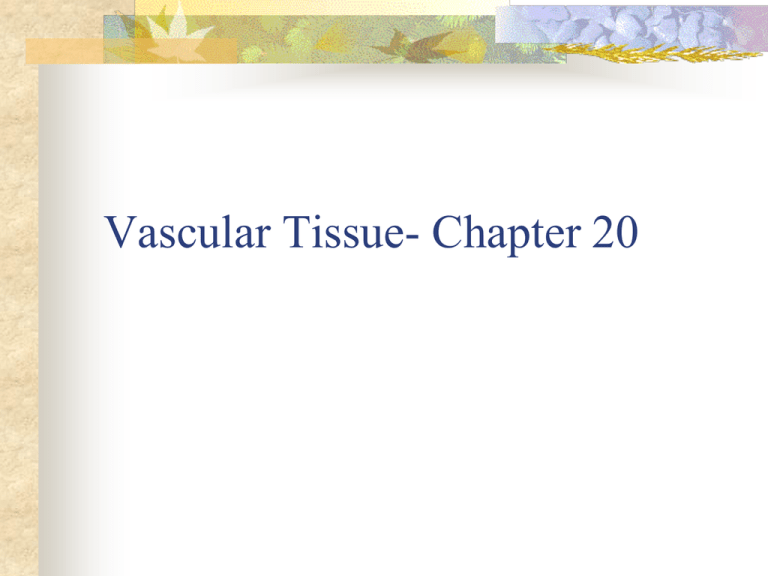
Vascular Tissue- Chapter 20 Concept 20.2 Root System Anchor & Support Absorb minerals and water Monocot root- fibrous-mat -grass Dicot root-tap root-1 vertical root-carrot Shoot System Stems, leaves, flowers Support Transport-transport tissue Plant Root and Shoot System Shoot System= stems, leaves, flowers Undeveloped shoots are buds. Terminal buds- stem tip Axillary- in the axils (angles) between leaf and main stem. Growth from here produces plant branches. Blade- main part of the leaf. Petiole- stalk connecting the leaf to the stem. Veins- carry water and nutrients-vascular tissue and support tissue. Examples of modified leaves Celery stalks- petioles; spines on cactus, tendrils Grass-no petioles. Plant tissue system-3 types 1. 2. Dermal Outer covering- “skin”- epidermis Protects Vascular Tissue- 2 types Transport Xylem- water and minerals from rootsshoots Phloem-food from leaves down. Roots-in center Stems- in vascular bundles. Monocot vs dicot differences Monocot vs Dicot Root Monocot vs Dicot stems 3. Ground Tissue- mostly parenchyma cells Fills in between the dermal and vascular tissues. Functions in photosynthesis, storage, and support in young shoots. Plant Tissue Is made up of more than 1 type of plant cell. Different cell types Parenchyma- thin c. wall & large vacuoles. Most abundant in fruit. Makes up phloem. Collenchyma- thick, uneven; provides support; elongates. Sclerenchyma- support; forms skeleton; makes up the water-conducting cells of xylem. Primary Growth- Concept 20.3 Plants grow throughout their lifetime. Meristematic Tissue- differentiates into the 3 main tissues- dermal, vascular, ground. Apical meristems- found tips of roots and shoots. Primary Growth- growth in length roots- below ground shoots- above the ground Primary Growth in Roots and Shoots Primary Growth- growth in length Figure 20-13 – Root cap-protects delicate cells of apical meristem. Primary growth -3 cylinders of developing tissues Outermost cylinder- dermal tissue Middle- cortex Inner cylinder- vascular tissue Xylem Phloem Concept 20.4Secondary Growth Woody plants – vines, shrubs, trees Growth in plant thickness- width Cell division in 2 meristematic tissues: vascular cambium and cork cambium Vascular cambium A cylinder of actively dividing cells Between the xylem and phloem Adds cells both sides Secondary xylem-wood. Secondary xylem inside Secondary phloem outside Growing season Dormant in winter Stem / root thickens with each new xylem Sapwood- new xylem actively transporting water Heartwood- old xylem not transporting water Secondary phloem- outside vascular cambium. Cork cambium meristem- produces cork When cork cells die-thick waxy wallsprevent water loss Barrier of protection Bark- everything to the outside of the vascular cambium Includes phloem, cork cambium, and cork Secondary Growth Tree rings Age from annual rings = year of growth Easiest to count dark bands of secondary phloem from outside to inside. Environmental conditions- differences in ring width. Each ring Spring- cool, plenty of water conditions Produce large, thin walled cells of xylem carry lots of water. Summer- hot, dry conditions Narrow thick walled cells Tree Rings- History of the Plant What nutrients do plants need? Concept 21.1 Plant get nutrients from _____ and _____. Air supplies carbon dioxide and ________. Water supplies hydrogen and serves as a solvent for dissolved minerals. Plants have simpler needs than animals Plants require 17 chemical elements for their life cycles Chemical elements needed/function Nitrogen- proteins and nucleic acids Sulfur- proteins Phosphorous- nucleic acid and ATP Potassium – protein synthesis and osmosis Na+-K+ pump Calcium-cell wall, enzyme activity Magnesium- chlorophyll synthesis, enzyme activity Consequences of poor nutrition Growth –stunted No flowers produced Stems, roots, leaves may die Yellow leaves if no chlorophyll produced Vascular transport Concept 21.2 Roots –absorb water and minerals Root hairs & Mycorrhizae Xylem- moves water and minerals upward 2 forces1. Root pressurePushes water up the xylem (at night) Root epidermal and ground tissue cells use ATP to get minerals – into xylem Endodermis around vascular tissue-waxy cellsprevents leakage of water. Water enters xylem by osmosis 2. Transpiration-pull Main force- pulls xylem up Transpiration- loss of water thru leaves due to evaporation. Cohesion : same kind molecules stick together water –water Adhesion : attraction between unlike molecules ( water – cellulose (xylem walls) Regulating water loss Stomata (singular-stoma) Pores on underside epidermis of leaf gas exchange – CO2 Guard cells surround stoma open and close stoma by changing shape Open- day- to let in CO2 Closed- night- to prevent water loss. Leaf Diagram- Structure Water follows potassium ions from surrounding cells into guard cells. Leaf Structure Leaf Cross-section Flow of Phloem Phloem- “food phloem down” Transports sugar and organic compounds + water. From source (mature leavesphotosynthesis) to sink (where needed- roots, fruits, developing shoots). Pressure-flow mechanism Water follows sugar; high conc. to low conc. Sieve tubes carry phloem sap Pressure-Flow mechanismhypothesis for movement of phloem sap. 21.3 Carnivorous Plants Some plants – N from animals Ex: sundews, Venus's flytraps, pitcher plants Little organic N where they live (wetlands, cold, acidic water, decay slow) Still photosynthesize Ch. 22.1 Plant hormones –chemical messengers Control: Germination Growth Flowering Fruit production 1. Auxins Apical meristems – shoot tips Cell elongation Secondary growth – vascular cambium Seeds – auxin – signal ovary to fruit Auxins - no pollination seedless fruit Phototropism Auxin builds – shaded side Shaded cells lengthen more, more water Uneven sides = bending 2. Cytokinins Cell division – made in roots Cytokinin with auxin Fewer / shorter branches near tip 3. Gibberellins Fruit – seedless, larger 4. Abscisic Acid (ABA) Limits cell division Stops growth Dormancy “stress hormone” 5. Ethylene Fruit ripening “leaf drop” 22.2 Plant Responses Rapid plant movements Touch Rapidly reversible Tropisms – slowly grow toward or away from a stimulus Slow to reverse 1. Thigmotropism Touch Climbing plants – tendrils Seedling - obstacle 2. Phototropism Light Uneven auxins – light one side 3. Gravitropism Gravity Seedling root / shoot Disease Viruses, bacteria, fungi Adaptations Epidermis Chemicals – lignin Resistant genes Thorns, poisons
